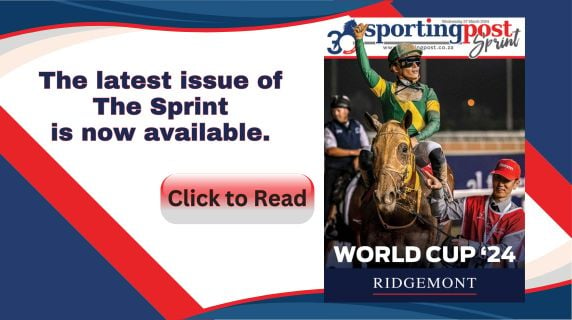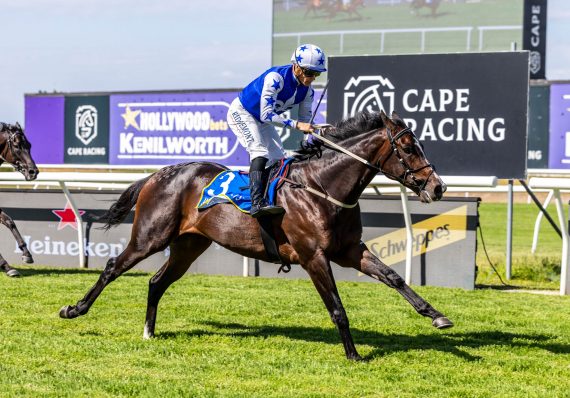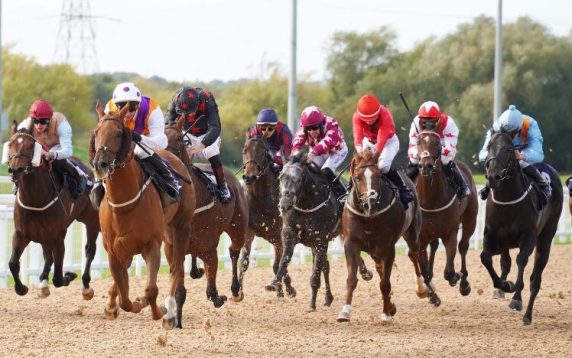Trade is vital to all countries and all industries.
When trade is blocked, the result is detrimental to the entire industry, and the resumption of trade provides hope and is a stimulus to economic growth, employment and to entrepreneurial enterprise, writes Robin Bruss.
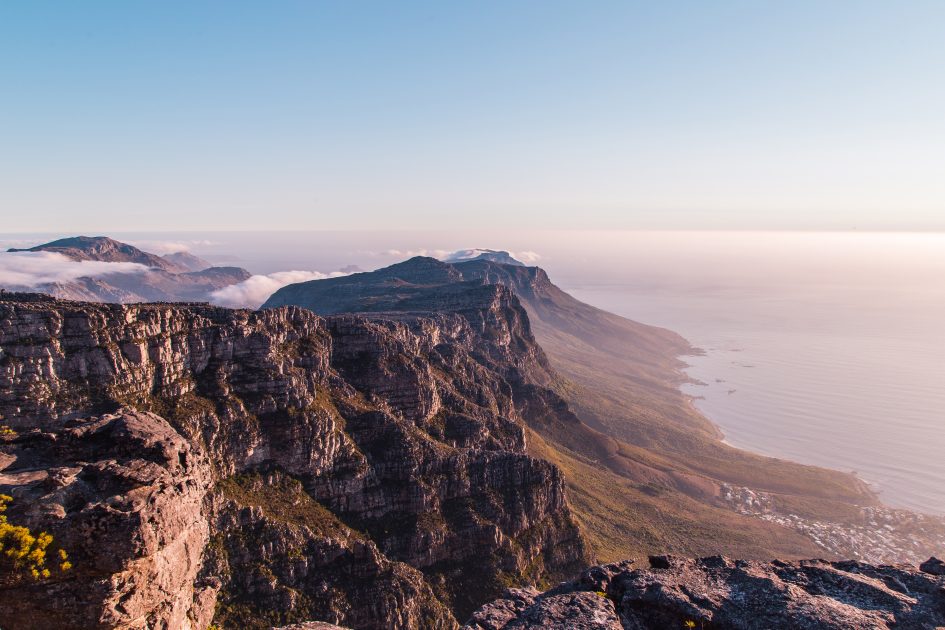
All of the South African racing and breeding industry has welcomed the renewal of the EU protocol which will allow direct exports to resume from Cape Town’s AHS Free Zone to the EU, and no doubt warrants the praise being heaped upon Adrian Todd, CEO of the SA Equine Health Protocol (SAEHP), the quasi-government body which works as a type of public private partnership with the Dept of Agriculture, Land Reform and Rural Development (DALRRD).
The Thirteen Year Wait
Thirteen years is an awfully long time to negotiate a veterinary protocol, which in itself should be based on science and risk analysis, but almost certainly involved the complexities of trade politics and the bureaucracy of dealing with a Union of 27 countries.
Since Adrian Todd assumed the CEO role in 2018, his six years were also affected by long delays with the EU bogged down in Brexit, as well as dealing with the Covid Pandemic, and the matter of South African horse imports would have sat low down the pecking order in terms of priorities.
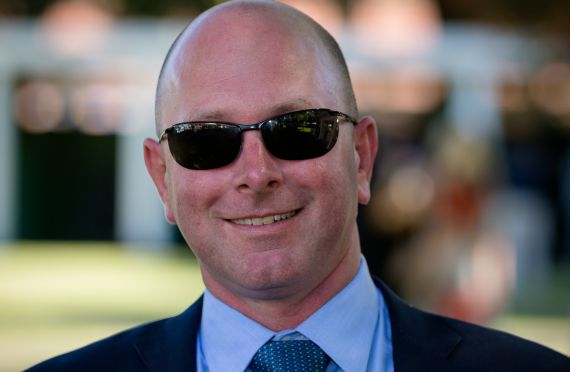
Adrian Todd
Todd wasn’t the only one to tackle the issue, as there were prior organizations before the set up of SAEHP, who spent 6 years on the job from the onset of the 2011 suspension without making much progress.
The 2011 suspension followed the deaths of a group of donkeys in Mamre township some 54 km away from the designated Free Zone in an area known as the Protection Zone (which covers a vast radius of around 100km) which has the purpose of catching any outbreak early and thereby protecting the sanctity of the Free Zone Area which stretches between Milnerton and Kenilworth in Cape Town.
The dead donkeys, it was later discovered, were suspected of having succumbed owing to having adversely reacted to being vaccinated.
Any death from AHS is reported as a notifiable disease and even a single case becomes the red flag for the suspension of the protocol, which according to the 1996 set-up of the zone, is a mandatory suspension of 2 years. And so began the 2 year suspension of exports in 2011 which has now lasted 13 years.
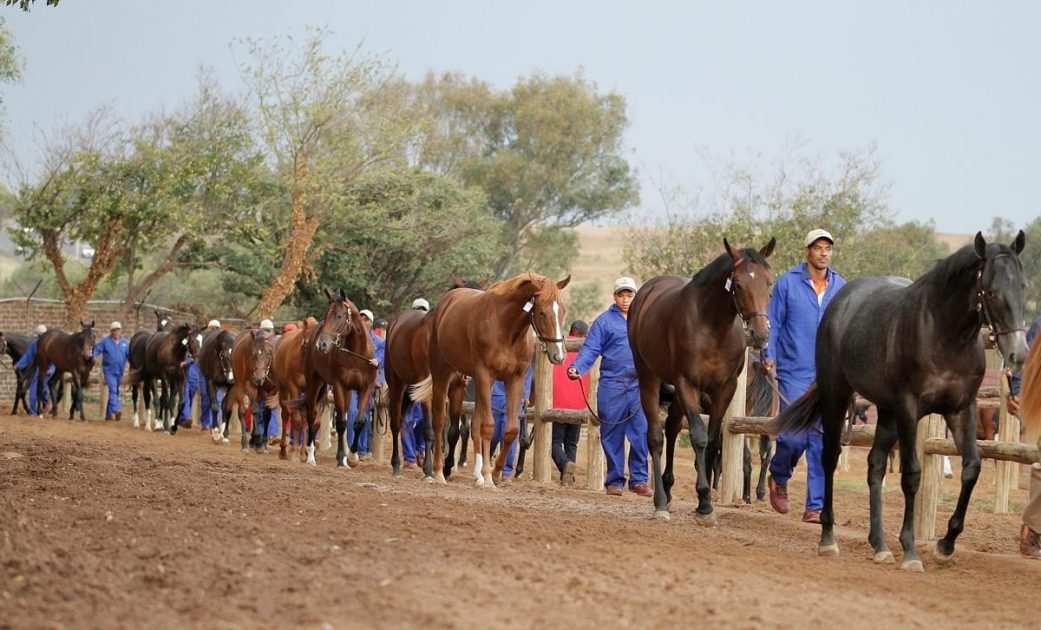
TBA Sales Complex at Gosforth Park (Pic – Candiese Lenferna)
However, the suspension could not be lifted when two years later in 2013, SA failed an EU audit and that had to be fixed first before any progress could be made.
These corrections were dealt with but who would know that owing to Brexit and Covid, the EU would not conduct and approve another audit until 9 years later in October 2022.
In the interim, according to the published EU Audit Report October 2022, a new Animal Health Law in the EU had rendered the legal authorization No 2008/698EC of the Free Zone to become obsolete, and that Law was required to be repealed in order for the authorization to be considered once again.
This required a different focus to the matter of trade and consequently has taken a long time to be achieved.
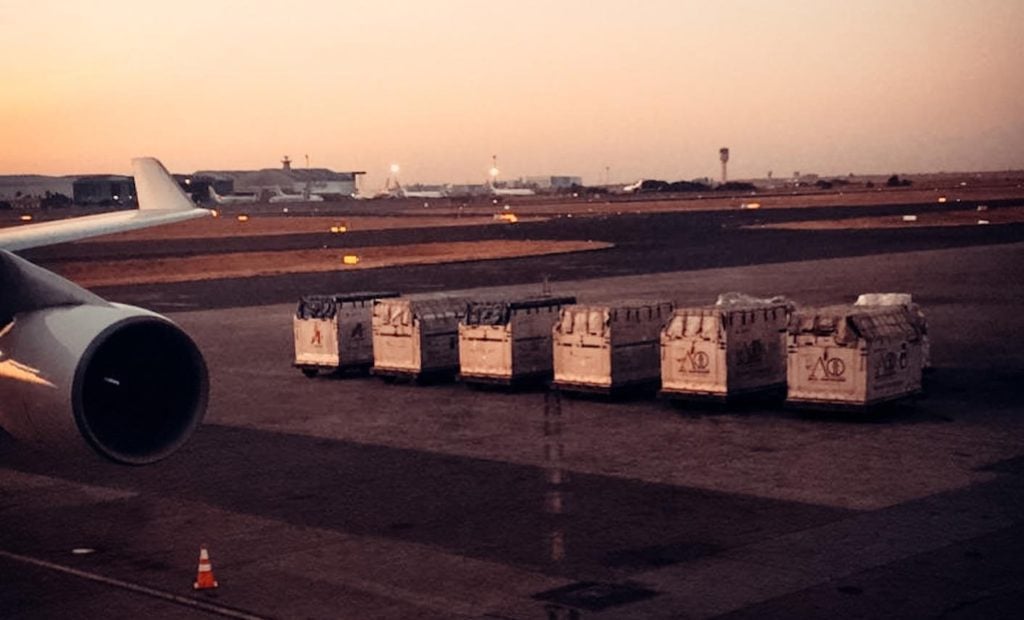
According to the SAEHP/DALLRD press release this week, the legalities are now in place and the authorization has been granted by the EU for the re-opening, although the detail of regulations around the protocol is not yet published and we must be cautious not to assume too much until the detail is made known.
In the past, the requirement was for a period of residence required in the Western Cape before entry into pre travel quarantine (PEQ) at Kenilworth racecourse quarantine and then 40 days in the quarantine stable with daily exercise permitted before flying out.
If a single case of AHS occurred in the Protection Zone, there used to the 2 year suspension and this had happened in 2004, 2006, 2011 and 2013.
Since AHS has a 10 days incubation period (like Covid) and is easily detected on a PCR test (again, like Covid) it therefore would be hoped that in the renewal, given the modern success of the PCR test, that the suspension period might be something practical like 30 days, and not punitive as the 2 year period used to be.
They say that in any regulation, the devil is in the detail, and therefore we look forward to the publication with a measure of hope and optimism.
Detrimental Effects of the old EU Direct-Trade embargo
To understand the detriment, let’s first understand what the 1996 advent of direct trade through the EU did for the breeding and racing industries which was positive.
USA Historical success
We knew that South Africa was capable of breeding horses of high calibre when in the 1960s, a spate of South African horses were sent to America to race.
America has a completely different importation policy to the rest of the world.
The US Department of Agriculture does not believe that animals should be Pre-Travel Quarantine (PEQ) tested by the exporting country and arrive with clearance certificates from foreign vet authorities.
The Americans prefer to trust themselves, so they go for Post Arrival Quarantine (PAQ) in their own facility, and if the animals don’t meet with strict standards they are sent back.
Europe, on the other hand, does not want to quarantine any horse on arrival, and therefore insist on PEQ in the horse’s home country and the EU audits the Authority, rather than the Horse!
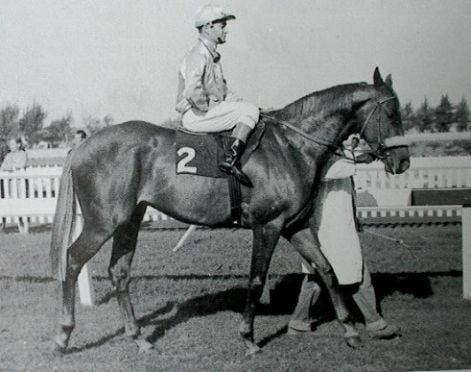
Colorado King
Colorado King (SAF) was the first South African to go to the USA after winning the Durban July in 1963 and he became the best horse in California, breaking the world record for 1800m.
The success of Hawaii (SAF) proved that South Africa was breeding world class horses – although considered inferior to Sea Cottage at home, he became Champion Grass horse in 1970 in USA and the first $1million South African stallion syndication.
America looked easy with weekly scheduled flights operating Johannesburg/New York with any horse booking a pallet and flying. But that was stopped in 2001 after 9/11 with all scheduled cargo flights being disallowed into New York.
The European ban from 1958 remained problematic as it was the gateway not only to Europe, but also to the Middle and Far East as well as Australia and it was an important matter to solve.
The Free Zone concept
In 1995, Prof Allan Guthrie of the Equine Research Centre seized upon the European principle of a Free Zone which had been authorized and used at the Barcelona Olympics in 1992, and he proposed a similar system to be set up in Cape Town -and ultimately it was approved.
London News (SAF) – the pioneer
When it was accepted as a system for competition horses to train during 40 days quarantine at Kenilworth racecourse, the first horse to try to raid internationally was London News (SAF), who completed his race preparation at Kenilworth, exercising in the morning and quarantining in the evening.
He then flew Cape Town-Amsterdam-Hong Kong and five days later he won the then biggest race in Hong Kong, the 1997 Queen Elizabeth Stakes (Gr1) over 2000m. And not only that, he broke the course record as well!
South Africa had arrived on the world’s stage.
Two years later, Barry Irwin’s Team Valor began buying in South Africa and their first horse Delta Form, winner of the Johannesburg Summer Handicap, left for America, where he won at Gr2 level and placed in Gr1.
It was enough for the TVI supremo to see the economic gap: Buy South African value in Rands and aim for USD success.
His results were spectacular. He took the risk no-one would, and his intrepidity has paid handsomely.
Spook Express, whom Mike de Kock had trained to Gr1 success in South Africa, was sold to the USA, winning the Keeneland Galaxy Gr2 and ran 2nd in the 2000 Breeders Cup Fillies and Mares World Championship.
Mike de Kock sent Horse Chestnut to America and then set up his stable in Dubai, and the South African juggernaut began with year on year success through to 2012.
In the first decade of the 2000s, South Africa, 8th largest racing country in the world out of more than 60 countries that race, was now showing its mettle in global competition.
Victory Moon and Ipi Tombe each became Horse of the Year in Dubai, TVI’s Irridescence won the Queen Elizabeth S. Gr1 in HK, Crimson Palace won the Beverly D Gr1 in Chicago.
Perfect Promise won the CF Orr S. Gr1 in Australia, Dane Julia won the Kelt S. Gr1 in New Zealand; on a memorable night in 2006, Jay Peg won the $5m Dubai Duty Free Gr1 and Sun Classique won the $5m Sheema Classic Gr1 in Dubai; JJ The Jet Plane won the Cathay Pacific Sprint Gr1 in HK, Gypsy’s Warning won the Matriarch S. Gr1 in California, Variety Club won the HK Mile Gr1 at Sha Tin and Shea Shea won the Al Quoz Sprint Gr1 in Dubai.
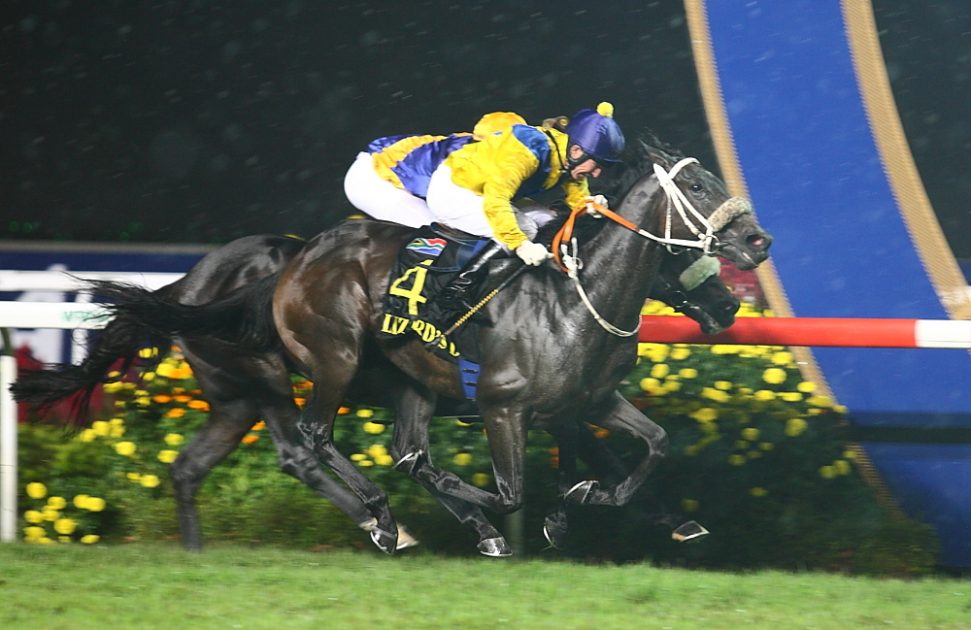
Lizard’s Desire wins the Gr1 Singapore Cup
Lizard’s Desire, bred in Port Elizabeth from a R5000 mare, was beaten a whisker in the first running of the world’s richest race, the $10m Dubai World Cup Gr1, then got his revenge on his conqueror when they met again in the $3m Singapore Cup Gr1.
South African horses were winning big on all five continents and Mike de Kock was the South African trainer in Dubai, attracting the investment of Sheik Hamdan deputy ruler of Dubai, and Sheik Mohammed bib Khalifa, who became big supporters of South African racing.
Racing South Africa
A new marketing arm, Racing South Africa was set up in partnership with the Racing Operators and the Racing Association, with the aim of supplementing the international racing picture with the international performances of South African horses, creating interest and enthusiasm in the SA product – it had a relentless drive to attract and bring more buyers to the SA auction sales.
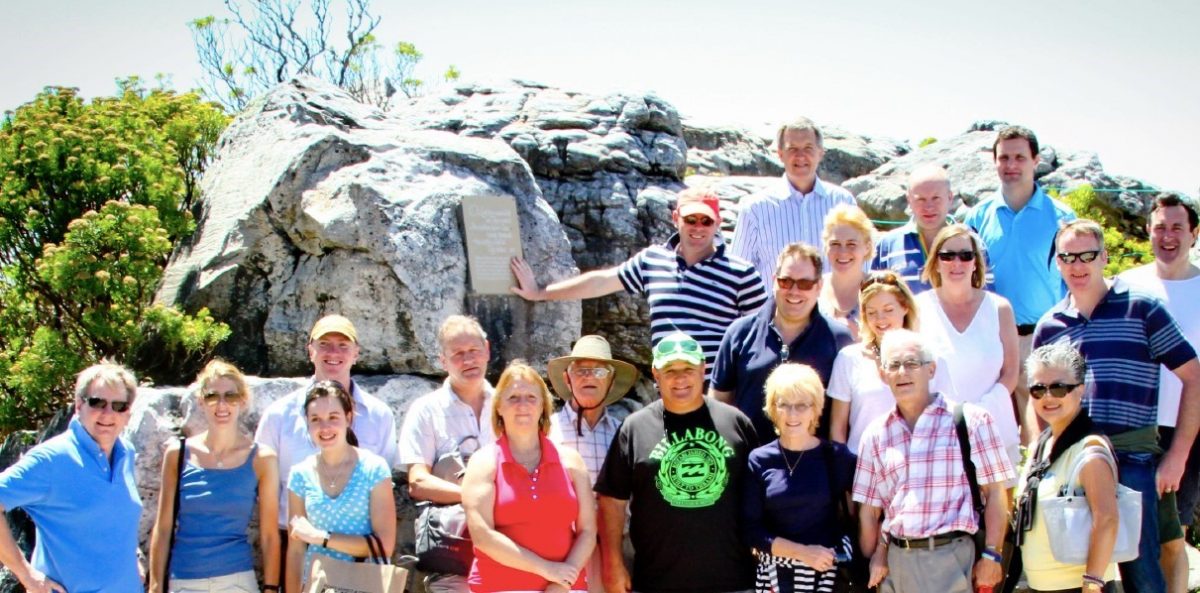
Overseas guests enjoy the splendour of Table Mountain
“We don’t just compete in big races around the world” laughed Racing South Africa’s CEO Peter Gibson at the time, “invariably we seem to win!”
Racing SA itself became recognized by the DTI as an official Trade Council which qualified it to receive R1 million p.a. to market the SA product across the world.
They held trade missions to HK and Singapore, Malaysia, Philippines, China and UK.
The success rate was felt at the National Yearling Sales:
“In 2001, only 1% of the TBA turnover was foreign money” wrote TBA Chairman Adv Altus Joubert in the TBA Annual Report 2009, “now it’s more than 30%”.
“Since 1996” he glowed, “the TBA Sales have increased year on year – until 2009 when we were affected by the global financial crisis – our first downturn after 14 years of growth.
“However, we continue to offer what I believe is the best value for money of any breeding industry anywhere in the world”.
The chart below of National Yearling Sale statistics from 2000 to 2010 reflects the impact of the growth curve.
In the 14 year period, the average price showed 430% growth. Similarly, the sale aggregate at the National Yearling Sale QUADRUPLED.
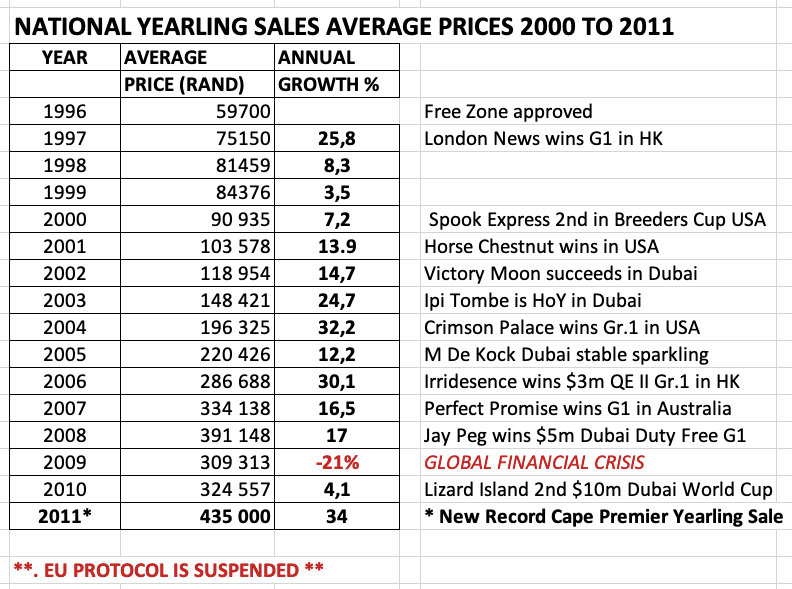
In 2011, the TBA elected to start the Cape Premier Yearling Sale inside the International Convention Centre in Cape Town.
It had a R2 million budget to fly in new buyers from around the world.
It had the support of the Western Cape Government with the Cape Premier Helen Zille opening the Sale and welcoming the foreigners.
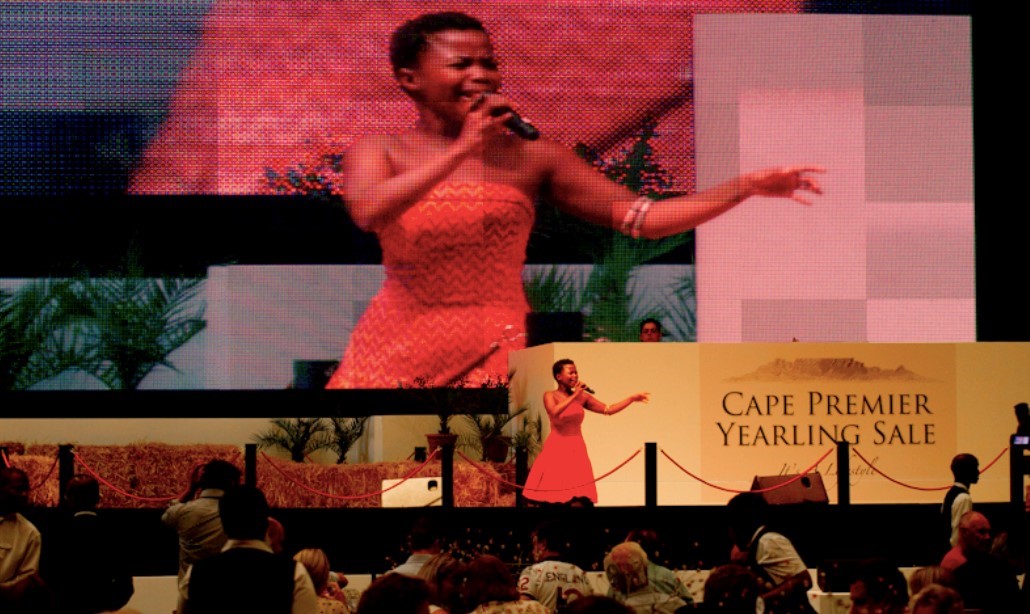
South African hospital at the Cape Premier Yearling Sale
It featured Mango Groove as a singing act to commence the sale as it hosted buyers from 18 countries and was lauded and congratulated for internationalizing the South African product at a time of the year – January – which suited all the Northern Hemisphere buyers.
The sale broke all records and for the TBA, the startling realization that 60% of the sale aggregate was by foreign purchasers.
The downside of the EU Suspension 2011
In 2011 there were 352 registered thoroughbred breeders, they owned 4,138 broodmares and stood 112 stallions.
In 2023, by comparison, and the downturn of 12 years of EU export bans, there were 185 breeders (48% reduction), they owned 2,329 broodmares (44% reduction) and stood 58 stallions (49% reduction).
To be fair, there were other significant factors which affected the health of the thoroughbred breeding industry, most notably, the Covid Pandemic 2020 and the bankruptcy of Phumelela which followed in 2021.
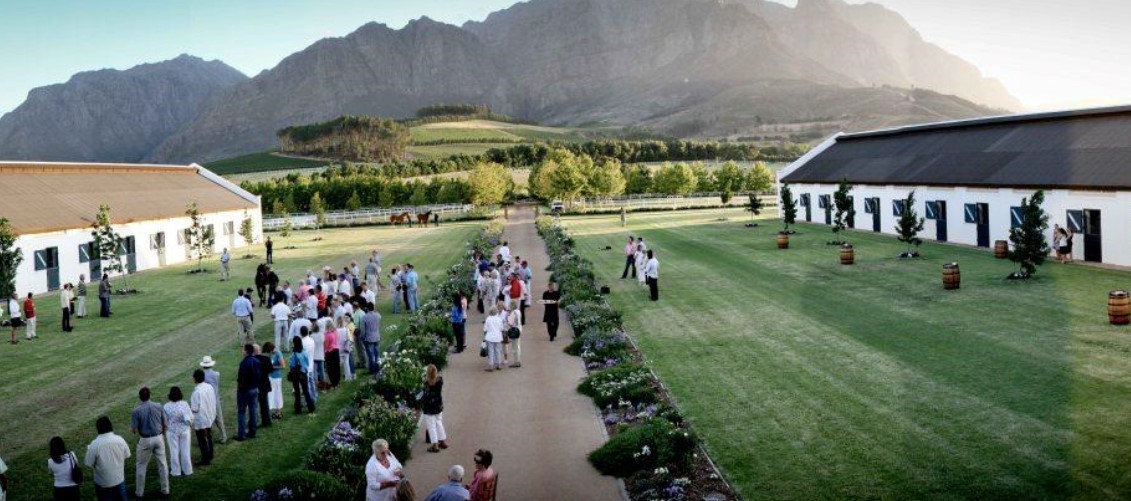
Overseas visitors enjoy the beauty of an SA stud farm
Racing South Africa was closed down, the Trade Council relationship terminated.
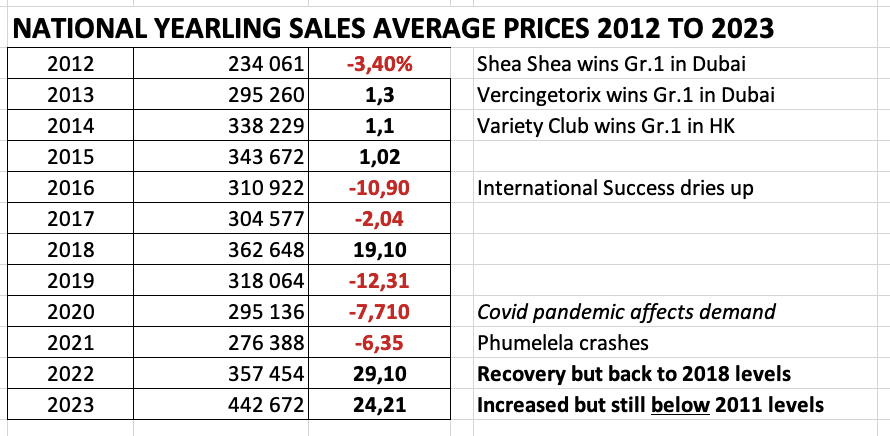
Notwithstanding 2020 and 2021 events, the decline began with the sustained reduction in foreign spend, the absence of South African successes around the world, and the realization that sights once set at massive international stake earnings such as Jay Peg (R46 million), Lizard’s Desire (R52 million), Sun Classique (R48 million), Variety Club (R32 million) and Iridescence (R19,7 million), were no longer going to be possible, unless a way could be found to freely export.
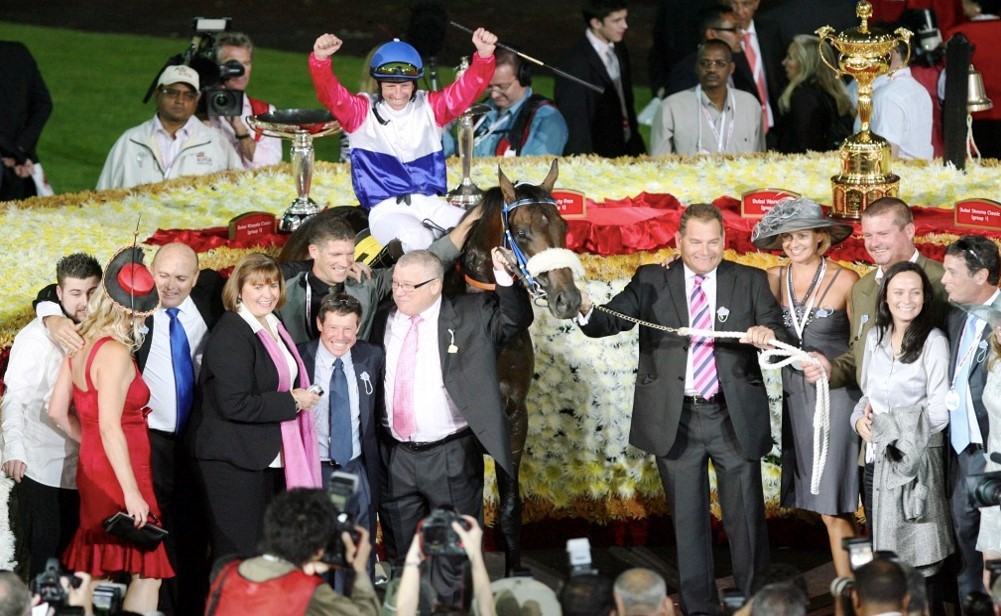
Jay Peg celebrations after victory in the $5m Gr1 Dubai Duty
In 2023 /24 in South Africa only, reigning Horse of the Year Princess Calla took her earnings to R5,5 million after 12 wins and five Gr1 races, and champions Charles Dickens to R5,119,813 and See It Again to R4,136,875.
Domestic prize money looks good when we are at home, but not so much when we look at foreign purses in booming Middle and Far East.
- Our richest race, the Hollywoodbets Durban July carries a stake of R5 million.
- The world’s richest, The Saudi Cup, carries a stake of $20 million (R366 million).
The 2024 Saudi Cup winner, Senor Buscador is a 6 year old who had not won any Gr1 in 17 starts in America and in six Gr1 attempts before his amazing Gr1 achievement in Saudi.
It’s hard not to think our best South African horses could be competitive in the 1800m event in the Kingdom of Saudi Arabia, especially in the light of the first decade of the 2000s.
The export protocol for easy and effective delivery for competition horses becomes the critical pathway to the opportunity to regain our global success, whether the horses are bought in South African by foreign buyers or whether South Africans will fly the flag themselves on the world’s stage.
It also stands to reason that if South Africa is the 8th largest racing country in the world and the average earnings per horse in Rands currently places us out of the top 20, then every country where the prize money is bigger becomes an “arbitrage” opportunity – that is, change the geography and the horse becomes worth more because it can earn more.
Quality Control and the Improvement of the Breed
What we don’t know right now is the current CLASS of our horses against the world’s best because it has been so long since we have been able to test them in global competition.
For this reason the recent bold move by Drakenstein Stud, Ridgemont Stud, Hollywood Syndicate, Mario Ferreira and Barry Irwin’s Team Valor, to take a significant group of top horses to America in the hope of getting runners in November’s Breeders Cup World Championship is to be commended.
On one hand, we know that the National Horseracing Authority’s handicapper is part of the 16 nation global panel that must agree the Longines World Ratings and the panel has agreed that our best horses like Do It Again, Jet Dark, Kommetdieding, Charles Dickens and Princess Calla have featured highly in the global rankings, most of whom would have ranked higher in ability than Senor Buscador on his form prior to Saudi Cup!
Opinions are one thing. The Winning Post is another. And stakes cheques are not paid on opinions!
Whilst we have witnessed the downturn in numbers of stallions and mares, it’s also true that in this same period, the number of horses imported to replenish the gene pool have been significantly low, that is, lower than at any time in our modern history.
According to the NHA, in 2023 there were 4 horses imported for breeding, in 2022 there were 6 and in 2021 there were 5.
How does the breeder positively impact the gene pool on such a paltry number?
And if only 3% of all horses win Graded Stakes races because Graded stakes are only 3% of all races, how can we expected just the 3% of Black type earners to improve and uplift the general population of horses ? Logically, the standards must deteriorate, and after a decade, even great families will decline.
If Breeders seriously want to see an export market flourish, and South African horses compete successfully on the world’s stage, they had better focus on IMPROVING THE GENE POOL.
Hand in hand with that assertion, the Department of Veterinary Services, DALLRD, no doubt currently buoyed by the success of the EU negotiation, had better also consider how best to ease the mechanism for IMPORTATION of horses, which, in my experience, are harder and more difficult and more expensive to import than at any time in the past 40 years.
The Export Market
- The Yearling Market will be boosted by foreign spend, enjoying the substantial discount of the Rand exchange rate and buying cheaper horses to race in South Africa in the hope to take the proven horses out later on.
- The Yearling Market will also be boosted by domestic buyers, hoping to find the great racehorses that will be able to compete in USD races or for Dirhams or Riyals in the great rich races of the desert.
- Whilst yearlings are significant, the real export market is going to be for young progressive proven horses and for Stakes winning fillies and colts where $100,000 (R1,8m) to $250,000 (R4,5m) offers will be hard to resist. This will be the domain of owners and trainers boosting income at a vastly higher value than the purses they can earn in South Africa.
Shortage of Horses
The double edged sword here will be the real risk of a shortage of horses to compete in local races – the 2023 population was 4688 horses in training, which is understandably down 20% from pre-Covid level of 5816.
There will be a concerted effort by the operators, most notably Cape Racing, to shore up prize money, especially in 2 year old racing, as they have done, in order to encourage young horses to remain.
If 4Racing and Gold Circle follow suit, the juvenile programme will be richer than ever before and incentive owners not to sell too quickly – and there will be the knowledge that, in order to keep more horses at home, prize money must go up.
What this will also do, is for demand to exceed supply and that means prices will rise. Breeders will finally overcome the desert of the last dozen years where flagging prices have not kept pace with rising costs and almost half the studs have gone out of business.
But if breeders want to stay in business and prosper, they and the TBA and the Department of Veterinary Services will need to have a serious discussion on how to replenish the gene pool and how to service and grow the foreign markets that really suit them.
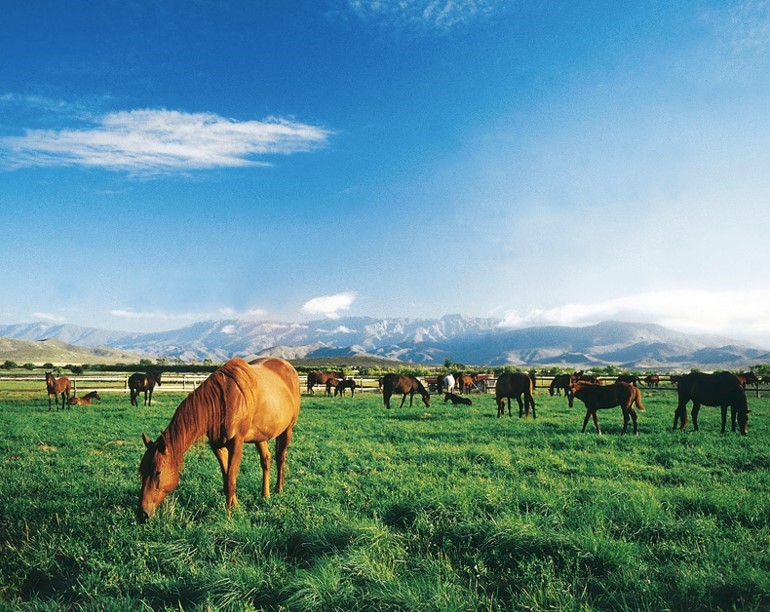
Breeders big and small will be thrilled
In this respect the Ministry of Agriculture should be a willing contributor – the Minister’s published Strategic Directive 2020 to 2025 puts the number 1 priority for the Ministry of Agriculture to be a focus on EXPORTS:
“Agriculture is one of the most important sectors with the greatest potential economic growth and job creation. The growth in exports cannot be over emphasized.” – Minister AT Didiza
Action and not words will be needed to fulfill this imperative. ncentives, tax breaks, streamlined importation and import quarantine, can join an agenda.
Looking Ahead
Next week, we will look at the recent success rate of South African horses abroad.
Although few are racing, what we have tracked is the astounding successes of the small number of South African graded SW mares that are at stud overseas, none more so than those who have found their way to Australia.
It is in the Middle and Far East where RESPECT runs high for the toughness and soundness of South African racehorses, and for the strictness of our drug rules.
However, it is in the Antipodes where RESPECT runs high for the South African racemares at stud and whose success rate is greater than South African breeders even know or realise.


